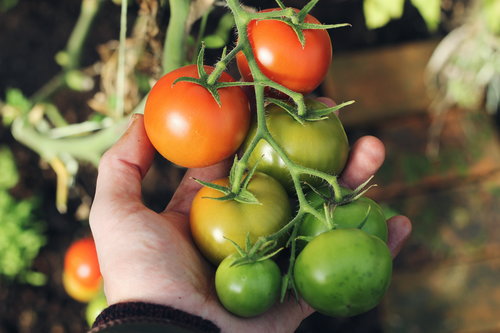Stay Home, Stay Safe
One of the best ways to avoid the virus and to stay home is to limit your trips to the grocery store as much as possible. Stocking up on non-perishables and freezerables (within reason of course) can help get you through a couple of weeks at a time. This has been the goal of my family as we try to get through this time but what we have struggled with is making sure we are getting enough fruits and vegetables to last – the crisper drawer only holds so much!
I was looking for help online on how to help keep vegetables to last longer and came across several conflicting posts about where to keep them, what temperature to set the fridge at and what other fruits or vegetables to keep next to them. At this point after becoming confused and overwhelmed, I did what any other millennial would do…call my mom!
Midway through explaining my predicament, she interrupted me and said “Aren’t you a landscaper? Make your own vegetable garden and then you can have fresh tomatoes all season!” Huh, yes I am and that makes a lot of sense. Plus my weekends and evenings could use a break from the consistent Netflix and popcorn marathons, especially since we’ve watched Tiger King – I don’t think anything will be as binge-worthy as that anytime soon.
After doing some more internet research and consulting with some local gardening experts including St. Jacobs Country Garden’s, I’ve compiled a step-by-step guide to help you create your own vegetable garden that you can do with limited tools and as few trips out of the home as possible!
-
Plan your garden location and what you want to plant
-
You want an area on your property that sees lots of sunlight. Vegetables take a lot more nutrients than a typical perennial and will need roughly 5-6 hours of sunlight.
-
Choose what you want to consume and research proper spacing, this will help determine the size of your garden.
-
Layout your garden, use string, marking paint, or a hose to plan the layout for your garden bed to help visualize it. Remember the bigger the garden the more work it’s going to be to start it and maintain it. The experts suggest picking an area where you can start small and then expand when you feel confident in your workload.
-
You also want to ensure your garden is going to be in a well-drained area – if you have somewhere that gets puddles or stays really wet after a rain you will want to avoid this area as vegetables that sit in water can often rot.
-
-
Prepare the garden bed
-
If the area you’ve chosen is currently grass you will want to remove all the turf, getting down enough to get the roots out but trying to keep as much native soil as possible. If the area is already a garden bed, remove any weeds that have grown in and rake any mulch back – you can use it after you have planted your vegetables. To potentially save time and back pain you can build a raised planter box – here’s a link to some pretty cool plans on how to do that.
-
Once your area is cleaned up you will want to add a nutrient-rich soil amendment such as compost or a garden triple mix soil. Use a shovel or garden hoe to mix the new compost or soil in with the native soil and then rake the garden area level. You want to make sure the top layer of soil is nice and loose to help the seed or roots easily navigate to find the nutrients they need.
-
-
Start with seed or plant?
-
This will depend on your budget, availability, and time of year. Seeds will be less expensive compared to a vegetable plant that has already started to grow, but depending on the time of year you may not have time to start with seeding in order for the vegetable to blossom in time to harvest.
-
The other issue you might come across is that during the lockdown you likely won’t be able to go into the garden centres to browse and see what’s available. Many local garden centres in our area are offering curbside pickup so make sure to call ahead to see how your favourite store is operating.
-
Make sure to follow all directions and guidelines when planting your vegetables including when it comes to spacing – an overcrowded garden can have some faster-growing plants choke out some slower-growing ones. Underneath the soil, there is an epic battle for nutrients so you want to ensure all plants get their fair chance!
-
-
Mulch
-
A great way to help maintain your new garden bed is to add a layer of mulch. Mulch helps with moisture retention and can prevent weeds from growing. You want to make sure you’re not adding too much mulch to the garden as it can sometimes choke out the plants.
-
Another option to consider is to use a product called Nincompoop. It’s wood-free so it’s a great alternative, especially in termite zones. As it breaks down it also turns into compost and feeds your garden!
-
-
Water
-
This is the most important part in determining the health of your vegetables. Too little or too much can be equally detrimental to the plant. When you water to want to ensure a deep soak so that the roots aren’t trying to climb to the surface for water. Here’s a great article on watering best practices.
-
-
Enjoy!
-
Harvest your ripe veggies and enjoy!
-
I hope this has been helpful and I wish you the best of luck with your own vegetable garden. If you do decide to tackle a vegetable garden be sure to post your pictures to our social media accounts.
As an added incentive for those who read this article, if you choose to buy any of your soils or mulches from us be sure to use code: Garden2020 upon checkout for 5% off your total order (valid until May 30th, 2020).



